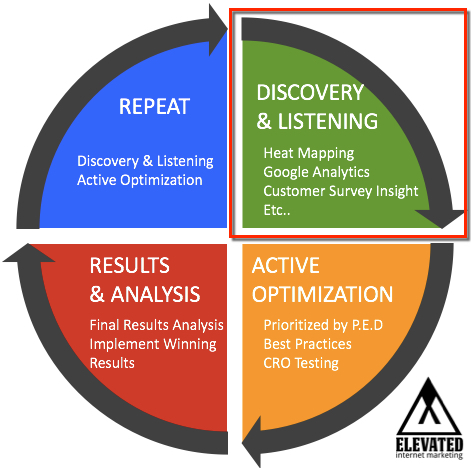
Generating ideas for your next conversion rate optimization test can be daunting, intimidating and sometimes downright confusing. But it does not have to be if you have an organized and methodical approach.
Many people think that simply following other people’s positive test ideas will give you the same positive results. This couldn’t be farther from the truth, as every website will produce different results.
Below is the life cycle of conversion rate optimization. The very first step in the process is the “Discovery & Listening” phase, which will be the foundation for your test ideation.
If you are embarking on conversion rate optimization for the first time it is critical to clearly define the specific conversion goals of your website and how the existing design applies to those goals. Every website is different and so are their goals. i.e. Engagement, Revenue, Add to Cart, Impressions, Email Signup, Form Fills, Phone Calls. I recommend picking 1 goal and exhausting your testing efforts before moving on to the next.
Who knows your customers better than your Customer Service team members? No one! They are your “boots on the ground” or “first line of defense.” I have found CS teams can easily identify customer pain points. i.e. Website Features Not Working, Unclear Return Policy, Confusing Shipping Information. Also, CS teams can identify a business’s “unique value proposition” which should be integrated into your testing ideas.
A great way to get qualitative feedback on your website is to deploy surveys to active visitors. Web analytics can tell you what people are doing, but a service like Qualaroo can give insight to the reasons behind visitor actions. Asking visitors that have been on 4-5 pages on your site the simple question “Have you found what you are looking for?” can provide powerful insights to for test development.
Understanding how visitors are interacting with your website will provide a wealth of testing ideas. Installing heat mapping software like Crazy Egg will show you where people are clicking and how far they are scrolling down. You just might find people are clicking on website elements they should not be, or not scrolling through pages you thought they would be.
In conversion rate optimization the saying “Imitation is the sincerest form of flattery” couldn’t be more true. Identifying and analyzing your competitors’ landing page / websites for brand messaging, value proposition, calls-to-action, etc. will generate lots of test ideas. A great place to find your competitor’s landing pages is simply Googling your relevant keyword targets and clicking on your competitors paid search ads. If your competitor is paying the money to advertise with Google you would hope that they are also performing conversion rate optimization tests.
Commissioning individual users to screencast their user experience / interaction on your website will provide real time feedback that will always generate testing ideas. Keep in mind this is more qualitative (rather than quantitative) data as it only provides the opinions of a few people and everyone may have different opinions! Usertesting.com is actually running a 5 minute free user testing video service (up to 3 a month) with a service called Peek. This is a great starting service to give you a taste of the power of user testing videos.
Website analytic platforms like Google Analytics can be a wealth of knowledge if you know where to look:
– Identify pages w/ high bounce rate
– Identify Pages w/ low conversion rate
– Setup goal funnel tracking to understand where visitors are leaving the conversion funnel
– Mobile Vs Desktop engagement metrics
– Google Site Search data: Identify what visitors are searching for, rather than where they are navigating to
Your last test is always a great starting point for generating your next test. In many cases your last test results can prove the complete opposite of your hypothesis. Ask yourself, why was this? What would have caused this? Then test on those hypotheses. Also, make sure that within your A/B testing platform, like Optimizely, you are segmenting your test results by different audiences. You might just find that your test reached statistical significance for mobile users but not desktop users.
Please be sure to let us know through the comments below. I would love to know what strategies have worked best for you and what has failed.
Of course, if you need help with your conversion rate optimization or just want to chat please get in touch with us.